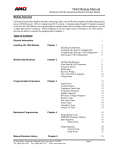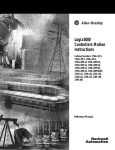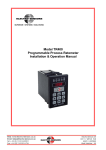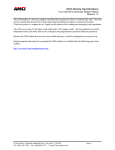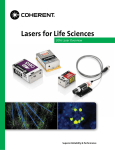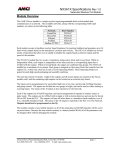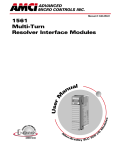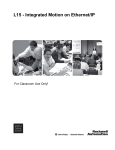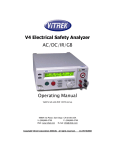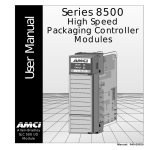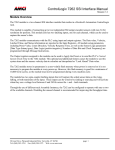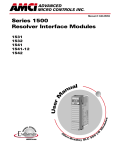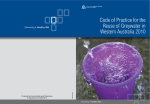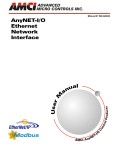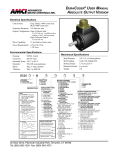Download AMCI 8213 Quick Start Guide - Advanced Micro Controls Inc
Transcript
AMCI 8213 Quick Start Guide ControlLogix Resolver PLS 20 Gear Drive, Plymouth Industrial Park, Terryville, CT 06786 Tel: (860) 585-1254 Fax: (860) 584-1973 E-mail: Sales @amci.com page: 1 AMCI 8213 Quick Start Guide ControlLogix Resolver PLS General Information Important User Information The products and application data described in this manual are useful in a wide variety of different applications. Therefore, the user and others responsible for applying these products described herein are responsible for determining the acceptability for each application. While efforts have been made to provide accurate information within this manual, AMCI assumes no responsibility for the application or the completeness of the information contained herein. Throughout this manual the following two notices are used to highlight important points. WARNINGS tell you when people may be hurt or equipment may be damaged if the procedure is not followed properly. CAUTIONS tell you when equipment may be damaged if the procedure is not followed properly. No patent liability is assumed by AMCI, with respect to use of information, circuits, equipment, or software described in this manual. The information contained within this manual is subject to change without notice. UNDER NO CIRCUMSTANCES WILL ADVANCED MICRO CONTROLS, INC. BE RESPONSIBLE OR LIABLE FOR ANY DAMAGES OR LOSSES, INCLUDING INDIRECT OR CONSEQUENTIAL DAMAGES OR LOSSES, ARISING FROM THE USE OF ANY INFORMATION CONTAINED WITHIN THIS MANUAL, OR THE USE OF ANY PRODUCTS OR SERVICES REFERENCED HEREIN. Standard Warranty ADVANCED MICRO CONTROLS, INC. warrants that all equipment manufactured by it will be free from defects, under normal use, in materials and workmanship for a period of [18] months. Within this warranty period, AMCI shall, at its option, repair or replace, free of charge, any equipment covered by this warranty which is returned, shipping charges prepaid, within one year from date of invoice, and which upon examination proves to be defective in material or workmanship and not caused by accident, misuse, neglect, alteration, improper installation or improper testing. The provisions of the “STANDARD WARRANTY” are the sole obligations of AMCI and excludes all other warranties expressed or implied. In no event shall AMCI be liable for incidental or consequential damages or for delay in performance of this warranty. Returns Policy All equipment being returned to AMCI for repair or replacement, regardless of warranty status, must have a Return Merchandise Authorization number issued by AMCI. Call (860) 585-1254 with the model and serial numbers along with a description of the problem. A “RMA” number will be issued. Equipment must be shipped to AMCI with transportation charges prepaid. Title and risk of loss or damage remains with the customer until shipment is received by AMCI. 24 Hour Technical Support Number Technical Support, in the form of documents, FAQs, and sample programs, is available from our website, www.amci.com. 24 Hour technical support is also available on this product. For technical support, call (860) 583-7271. Your call will be answered at the factory during regular business hours, Monday through Friday, 8AM - 5PM EST. During non-business hours, an automated system will ask you to leave a detailed message and the telephone number that you can be reached at. The system will page an engineer on call. Please have your product model number and a description of the problem ready before you call. 20 Gear Drive, Plymouth Industrial Park, Terryville, CT 06786 Tel: (860) 585-1254 Fax: (860) 584-1973 E-mail: Sales @amci.com page: 2 AMCI 8213 Quick Start Guide ControlLogix Resolver PLS Introduction Chapter 1 Module Overview 4 Chapter 2 Configuring the ControlLogix System Current Draw LED Function Installation Notes 5 6 6 7 Chapter 3 Resolver Wiring Remote Display Wiring Slave Mode Wiring Relay Board Connections 8 8 9 9 Chapter 4 Module Operation Parameters Module Setup Parameters Transducer Setup Parameters Limit Switch Parameters Group Setup Parameters Analog Output Programming 11 12 13 14 15 16 Independent Mode Operations Chapter 5 17 Group Mode Operations Chapter 6 Group Inputs Group Modes 18 19 Chapter 7 Input Registers Output Registers 21 23 Chapter 8 Instruction Format Message Configuration Window Configuration Window Data Communication Tab Function Reading Status Configuration Window Data Extended Error Codes 24 24 25 26 26 27 Installation & Specifications Wiring Programmable Parameters Input & Output Data Message Instructions Setup, Group, Output, & Analog Programming Reading Status Information Creating User Defined Data Types Chapter 9 Setup Programming Group Programming Limit Switch Output Programming Analog Output Programming 28 29 30 34 Chapter 10 35 Appendix A 20 Gear Drive, Plymouth Industrial Park, Terryville, CT 06786 Tel: (860) 585-1254 Fax: (860) 584-1973 E-mail: Sales @amci.com 37 page: 3 AMCI 8213 Quick Start Guide ControlLogix Resolver PLS Chapter 1: INTRODUCTION The 8213 module plugs directly into the ControlLogix rack and is in constant communication with the processor. Each module accepts a brushless resolver based transducer for position feedback and generates up to 32 limit switch outputs based on the transducers’ position and velocity. The 8213 module has several modes of operation that allow you to enable or disable the outputs based on discrete inputs and the speed of the machine. The 8213 module has the ability to control a total of 32 outputs, 16 Physical outputs and 16 Virtual Outputs. “Physical” inputs and outputs are physically connected to the 8213 module. Physical Inputs are brought into the module through external boards and are opto-isolated. Physical outputs are brought out to external relay boards. These DIN rail mountable boards use fused, plug in, solid state relays to drive AC or DC loads. Physical outputs are updated every 100µsec. The actual update time is based on the number of outputs and features used in the module and has a maximum value of between 200 and 300µsec. “Virtual” inputs and outputs are transmitted over the backplane only. Virtual I/O can be used on machine functions that do not require a 100µSec update time. By using Virtual Outputs you can significantly reduce processor scan times by off loading the limit switch calculations from the ControlLogix processor to the 8213 module. The 8213 module does not have a direct physical connection to Virtual I/O. The ControlLogix PLC’s ladder logic program must monitor or control these bits and if desired use AllenBradley ControlLogix I/O modules to connect the Virtual I/O to the real world. Virtual I/O is stored in the processors’ I/O data tables and is automatically updated at the RPI time. Optionally, the 8213 module can be configured to generate an interrupt every time one of the Virtual Outputs changes state. The 8213 module has two modes of operation, Independent Mode and Group Mode. While in Independent Mode, each output is independent of the others and has a corresponding input that is ANDed with the output. When in Group Mode, the outputs are combined into groups. The 8213 module has a maximum of six groups. Each group is assigned an Operating Mode that controls how the outputs fire. At this time, there are a total of six Operating Modes. These Operating Modes are geared towards high speed packaging and assembly machines. The 8213 module also has the ability to control two analog outputs. These outputs can be either Analog Voltage or Current and are based on the speed of the resolver. However, using the Analog outputs reduces the number of physical outputs from 16 to 12. Sample programs showing how to program the 8213 module in both Independent Mode and Group mode are available from the Tech Library Section of our website, www.AMCI.com. 20 Gear Drive, Plymouth Industrial Park, Terryville, CT 06786 Tel: (860) 585-1254 Fax: (860) 584-1973 E-mail: Sales @amci.com page: 4 AMCI 8213 Quick Start Guide ControlLogix Resolver PLS Chapter 2: INSTALLATION & SPECIFICATIONS Configuring the ControlLogix System 1. 2. 3. 4. Open RSLogix 5000 and the project in which you want to install the AMCI 8213 module. Right click on I/O Configuration in the Project Tree. Select New Module. Select the following module type and description from the list that appears. Type = 1756-MODULE Description = Generic 1756 Module (There is no EDS file available for the 8213 module. Because of this it will appear as an Unknown Device when viewed from RSNetWorx.) 5. Click on OK. 6. Enter the following module properties. Name: Your Choice (must begin with a letter) Description: Your Choice Comm Format: Data-INT (must be Data-INT) Slot: location of 8213 module 7. Enter the Connection Parameters from the following table. Please note the different parameters for Independent and Group Mode operations, and that power must be cycled to the unit when switching between the two. CONNECTION PARAMETERS Independent Mode INPUT OUTPUT CONFIGURATION Assembly Instance 100 194 1 Size in 16 bit words 7 8 0 Group Mode INPUT OUTPUT CONFIGURATION 101 194 242 13 8 0 8. Click on Next > 9. Set the RPI (Rate Packet Interval) Time to the desired value. To reduce the PLC scan, the recommended RPI time is 5ms. However, the minimum value for the 8213 module is 0.3ms. 10. Click on Finish >> 11. The module should now appear in the project tree. The Input data will be referenced as Local:X.I.Data[Y] and the output data will be referenced as Local:X.O.Data[Y] where “X” is the slot number and “Y” is the word number. 20 Gear Drive, Plymouth Industrial Park, Terryville, CT 06786 Tel: (860) 585-1254 Fax: (860) 584-1973 E-mail: Sales @amci.com page: 5 AMCI 8213 Quick Start Guide ControlLogix Resolver PLS Current Draw: 450mA @5Vdc 55mA @ 24Vdc typical 200mA @ 24Vdc with reference voltage shorted Throughput Time: 200µs to 300µs Front Panel: AMCI Status OK PLS LED Function Status LED Solid Red: Module Fault, such as no reference voltage Blinking Red: Non Clearable Transducer Fault Blinking Green: Clearable Transducer Fault Solid Green: Module and Transducer are OK OK LED Solid Green: Module Owned, two way communication Blinking Green: PLC is in Program Mode or one way communication, module only sends data to the PLC Blinking Red: Communication between module and PLC interrupted Input Function The inputs to the 8213 have a debounce time of 0ms, and are scanned every 1ms. However, if the 8213 is operating in Group Modes 1 or 2, than the input is scanned every 100µs. In Independent Mode, each input is anded with each output. That is, input 1is anded with output 1, input 2 is anded with output 2 … input 16 is anded with output 16. In group mode, the inputs have the following functions. Input 1 2 3 4 5 6 7 8 9 to 16 Function Group 1 Control Group 2 Control Group 3 Control Group 4 Control Group 5 Control Group 6 Control Limit Switch Enable Input First Cycle Input Not used in group mode 20 Gear Drive, Plymouth Industrial Park, Terryville, CT 06786 Tel: (860) 585-1254 Fax: (860) 584-1973 E-mail: Sales @amci.com page: 6 AMCI 8213 Quick Start Guide ControlLogix Resolver PLS Installation Notes 1. The 8213 module does not have a non-volatile memory and must be configured at every power up. This includes parameters such as scale factor, offset, direction, On/Off Setpoints, etc. 2. All module setup parameters, Scale Factor, Offset, Preset, Direction, Group Setup, and Limit Switch Outputs are programmed with the respective Ladder MESSAGE Instruction, and are triggered by either the 0 to 1 or 1 to 0 toggling of the programming blocks transmit bit. The MESSAGE Instruction uses an Instance Parameter to indicate to the 8213 module what data is being sent with the message instruction. For example, an Instance value of 200 is used to program the 8213 modules Setup data. 3. There are two force functions, Force On and Force Off. Both are programmed in the output registers. When a Force On bit is set, the output it represents will be activated, regardless of the output state. When a Force Off bit is set, the output is represents will be turned off, regardless of the output state. The Force Off function takes priority over the Force On function. 4. The inputs to the 82132 have a debounce time of 0ms, and are scanned every 1ms. However, if the 8213 module is operating in Group Modes 1 or 2, than the input is scanned every 100µs. 5. In group modes 4 and 5, inputs will be acted on only if the position data is scanned between the programmed group channel’s On and Off points. If the resolver position data passes through the group channel in less than 1 ms, the input may not be detected. 6. If the Limit Switch Outputs are programmed with message instance numbers 201 and 202, than only 4 physical and 4 virtual outputs can be programmed as timed outputs. 7. If the Limit Switch Outputs are programmed with message instance 204, Time Mode, than all 16 physical outputs can be programmed as timed outputs, each one with up to 2 time dwells. However, virtual outputs will no longer be available. 8. In time mode, the output must be on for at least 1ms and off for 1ms for a second timed output to fire correctly. This includes both the programmed timed value and the programmed number of resolver counts. If 2 On/Off setpoints overlap or the time between the first and the second is < 1mS, the module generates only one pulse. 9. The module’s power must be cycled when switching from Group Mode to Independent Mode or vice versa. 20 Gear Drive, Plymouth Industrial Park, Terryville, CT 06786 Tel: (860) 585-1254 Fax: (860) 584-1973 E-mail: Sales @amci.com page: 7 AMCI 8213 Quick Start Guide ControlLogix Resolver PLS Chapter 3: WIRING A CTL-(x) cable, where (x) is the length in feet, is used to connect AMCI single resolver transducers to an 8213 module. If you order a CTL-(x) cable from AMCI that is less than 100 feet long, we ship a cable that is made from Belden 9873 or equivalent. If you order a CTL-(x) that is over 100 feet, we ship a cable made from Belden 9730 or equivalent. One end of the CTL-(x) has a Bendix MS connector that mates with all AMCI single resolver transducers that have a connector. The other end is pigtailed at the factory for easy connection to the MS-8P connector included with the 8213. The following is a wiring diagram from a CTL to the 8213’s MS-8P. Transducer Cabling Information 1. Pin 1 is at the bottom when the MS-8P connector is installed in the 8213 module. 2. The shield pins can be connected to the mounting tab of the rack chassis to provide a better low impedance path to ground. 3. Transducer signals are low voltage and low power. If you are using A-B guidelines for cabling installation, treat the transducer cable as a Category 2 cable. The transducer cable can be installed in conduit along with other low power cabling such as communication cables and low power ac/dc I/O lines. It cannot be installed in conduit with ac power lines or high power ac/dc I/O lines. 4. The shield of the cable must be grounded at the 8213 only. If you must splice the transducer cable, it must be done in a grounded junction box. When splicing, treat the shield as a signalcarrying conductor. Do not connect the shield to earth ground at the junction box or transducer. If your transducer cable has individually shielded pairs, then ideally the shields in the cable are also kept isolated from each other in the junction box as well. Remote Display Connector and cable Shields Pin 1 6 pin connector on 8213 module. When plugged in, pin 1 is at the top. Also, pins 1, 2, and 5 are open. 4 pin connector plugs into the 6102 remote display unit. When plugged in, pin 1 will be located towards the outside of the module. Pin 1 20 Gear Drive, Plymouth Industrial Park, Terryville, CT 06786 Tel: (860) 585-1254 Fax: (860) 584-1973 E-mail: Sales @amci.com page: 8 AMCI 8213 Quick Start Guide ControlLogix Resolver PLS Slave Mode Connectors and Cable Master Connector pin 4 pin 3 pin 1 Note: When plugged into the module, pin 1 will be located at the top of the connector pin 6 Slave Connector pin 5 pin 1 Relay Board Connections There are three possible relay boards that can be used with the 8213 module. The possible combinations are one RB-7, one RB-8, a RB-8 and a RB-7, two RB-8s, or one RB-9. Part Number RB-7 RB-8 RB-9 Number of Inputs and Outputs 8 outputs 8 outputs and 8 inputs 16 outputs Current Draw (@24Vdc) 100mA 125mA 200mA Interconnections between the 8213 and relay boards are made with CRP-(x) cables, where (x) is the length in feet. Presently, two, six, and twelve foot cables are available from AMCI. CRP cables are shielded, fine pitch ribbon cables with drain lugs at both ends. Due to their complexity, AMCI strongly recommends that you purchase pre-assembled and tested CRP cables instead of making them yourself. Connections are made by inserting the blue IDC connector into the proper socket and connecting the drain wire to the screw terminal. Note that the IDC connector is keyed and can only be inserted in one way. The retaining clips on the IDC socket snap over the top of the connector to secure it in place. The drain wire on the CRP cable must be connected to the screw terminals next to the IDC sockets. The screw terminal on the 8213 module is connected to Earth Ground. The two screw terminals on the RB-8 relay boards are connected together. RB-8’s have two IDC sockets that allow you to daisy chain a second relay board to it. The CRP cable from the 8213 is connected to the socket labeled “CN1” on the first RB-8. A second CRP cable is connected from the “CN2” socket of the first RB-8 to the “CN1” socket of either a RB-7 or RB-8. The first RB-8, the one connected to the 8213, has the Inputs and Outputs 1 to 8. If the second relay board is an RB-7, it has the Outputs 9 to 16. If the second relay board is an RB-8, it has the Inputs and Outputs 9 to 16. An external, isolated +24Vdc supply is needed to drive the inputs and relays. Connect +24Vdc to the +24V terminal, the power supply common to the GND terminal. The required current is shown in the above table. Note that these measurements are for the relay boards only. If you are using an RB-8 and powering the input sensors with the same supply, then you must add in the current requirements of each sensor to determine the power supply size. 20 Gear Drive, Plymouth Industrial Park, Terryville, CT 06786 Tel: (860) 585-1254 Fax: (860) 584-1973 E-mail: Sales @amci.com page: 9 AMCI 8213 Quick Start Guide ControlLogix Resolver PLS Compatible Relays Every output requires a solid state relay. These relays are fused protected and have a retaining screw and indicator LED. These relays are available from AMCI under the following part numbers. KD-6 KA-3 Output Voltage 3 to 60Vdc 120Vac Rated Current 3Adc 3Aac Chassis Ground When a relay board is DIN rail mounted the case is isolated from the panel by the plastic DIN rail adapters. You MUST run a heavy gauge wire from the Chassis GND terminal of the power supply terminal block to your ground bus to ground the metal relay board case. When a relay board is panel mounted the case is usually connected to chassis ground through the mounting hardware. If you believe that the ground is insufficient then run a heavy gauge wire from the Chassis GND terminal to your ground bus. RB-8 Sink / Source Inputs The RB-8 inputs are connected to the TB1 terminal block. There are nine pins, one for each input and an Input Common. All inputs are opto-isolated and floating. That is, they are configured as sinking or sourcing inputs by connecting Input Common to a power supply. Typically, the +24Vdc supply that powers the output relays is also used to power the inputs. When Input Common is attached to +Vdc the inputs will source current into the sensors attached to them. When Input Common is attached to the power supply GND the inputs will sink current from the sensors attached to them. If you are using all sixteen inputs they are split between the two RB-8’s. Note that the two banks of inputs can be configured differently. For example, Inputs 1 to 8 can be configured as sinking inputs and Inputs 9 to 16 can be configured as sourcing inputs. 20 Gear Drive, Plymouth Industrial Park, Terryville, CT 06786 Tel: (860) 585-1254 Fax: (860) 584-1973 E-mail: Sales @amci.com page: 10 AMCI 8213 Quick Start Guide ControlLogix Resolver PLS Chapter 4: PROGRAMMABLE PARAMETERS The 8213 module is programmed from the backplane using a combination of I/O data words and Message Instructions. The module is setup by setting its Programmable Parameters. The programmable parameters are broken down as follows: Module Operation Parameters – These functions allow the PLC to directly control the functions of the Groups and the Limit Switch Outputs. Module Setup Parameters – Parameters that set the modules’ mode of operation, whether or not the module generates a processor interrupt, the active state of the physical inputs, and the forced state of the outputs. Parameters that scale the tachometer data and program the setpoints of the two motion detectors are also included in the module setup parameters. Transducer Setup Parameters – Parameters that affect the resolver position data. Limit Switch Parameters – Parameters that program the type of limit switch, any ANDing with the motion detectors or Enable Input, and setpoint and advance parameters. Group Setup Parameters – If you configure the module to operate in Group Mode then you also have Group Setup Parameters. These parameters assign the number of limit switch outputs in the group, the Operating Mode of the group, the setpoints of the Group Channel, the Group Offset / Preset value, and the inputs that are used to enable the group outputs. Module Operation Parameters Increment/Decrement This feature allow the PLC to either increase or decrease the On or Off setpoint of a Limit Switch output by one count at a time. It is possible to change just the On setpoint, just the Off setpoint, or both at the same time. Please note that the Increment/Decrement function only changes the On/Off setpoints in the 8213 module’s memory. The On/Off setpoints that are stored in the PLC’s memory are not changed by the Increment/Decrement function. Output Forces You can force any output on or off by setting the appropriate bit in the output image table. A Force OFF bit takes precedence over the corresponding Force ON bit. That is, if both the Force Off and Force On bits are set at the same time, than the output will be Off, not On. Virtual Inputs When the 8213 module is operating in Group Mode, the Virtual Inputs are used as the inputs to the Virtual Groups. That is, the 0 to 1 transition of these bits will activate the various group functions, such as enabling the outputs or changing the Group Position to the Group Preset value. The Virtual Inputs have no function if the 8213 module is operating in Independent Mode. Input Forces You can force any Physical Input on or off by setting the appropriate bit in the output image table. A Force OFF bit take precedence over the corresponding Force ON bit. Virtual Inputs cannot be forced in this manner. You must force Virtual Inputs on or off with ladder logic. 20 Gear Drive, Plymouth Industrial Park, Terryville, CT 06786 Tel: (860) 585-1254 Fax: (860) 584-1973 E-mail: Sales @amci.com page: 11 AMCI 8213 Quick Start Guide ControlLogix Resolver PLS Module Setup Parameters Tachometer Response A bit value that sets how often the 8213 module updates the tachometer data to the processor. The two choices are 120 mSec and 504 mSec. The default value is 504 mSec. The 8213 modules have two motion detectors that can be used to disable outputs when the machine speed is outside of the motion detectors programmed range. These motion detectors are also updated at the programmed Tachometer Response time. Internally, the tachometer is updated every 24 mSec. This update time is used when calculating the limit output advance values. Change of State (COS) A bit value that configures the module to send the new virtual output status to the PLC each time the state of one of the virtual outputs changes state. While using the COS function will decrease the throughput time of the Virtual Outputs, it will also increase your overall ladder logic scan time. Slave Mode A bit value that configures the 8213 module to operate either as a Master module or as a Slave module. If more than 16 physical outputs are required, it is possible to connect two 8213 modules together. The first, the Master, will be connected to the resolver. The second, the Slave, will receive the resolver’s position data from the Master module over a serial connection. An 8213 module operating in Slave mode will receive the position data 100µs after the Master module has calculated the resolver’s position. Serial Port Function A bit value that is used to define the function of the 8213 module’s serial port. If this bit is reset, the serial port will be used to transmit position and velocity data to an AMCI 6102 remote display unit. If this bit is set, the serial port will be used to either transmit data as a Master unit or to receive data as a Slave unit. Tachometer Scalars The 8213 module allows you to scale the tachometer value reported to the processor. Therefore you can have the 8213 report a tachometer value scaled to boxes per minute, inches per minute, or any other meaningful value instead of revolutions per minute. The tachometer is scaled with three values, Tach Multiplier, Tach Divisor, and Tach Decimal Point. The tachometer reports the rounded off integer value of the equation: (((Speed[RPM] * Tach Multiplier) / Tach Divisor ) / Tach Decimal Point). The Tach Multiplier can be any integer between 0 and 1,100. The Tach Divisor can be any integer between 1 and 63. The Tach Decimal Point can be 1, 10, 100, or 1000. As an example, assume a speed of 100 RPM, a multiplier of 2, a divisor of 3. The table below shows the different Tachometer values based on the Tach Decimal Point value. Calculated Tach Reported Tach 1 66.67 67 Decimal Point Value 10 100 6.67 0.67 7 1 1000 0.067 0 When programming the Tach Decimal Point, you enter 0, 1, 2, or 3 into your programming data. This corresponds to a Tach Decimal Point Value of 1, 10, 100 or 1000. 20 Gear Drive, Plymouth Industrial Park, Terryville, CT 06786 Tel: (860) 585-1254 Fax: (860) 584-1973 E-mail: Sales @amci.com page: 12 AMCI 8213 Quick Start Guide ControlLogix Resolver PLS Physical Input Active State These sixteen bit values program the active state of the Physical Inputs. When an Active State bit is set to its default value of zero, the corresponding input works like a normally closed relay. The input must have current flowing through it to be deactivated. When an Active State bits is set to one, the corresponding input works like a normally open contact. The input must have current flowing through it to be activated. Motion Detector ON/OFF setpoints The 8213 has two motion detectors, MD1 and MD2, that function as speed based limit switches. You program a low speed setpoint and a high speed setpoint for each motion detector. If the low speed setpoint is less than the high speed setpoint then the output will be on when the velocity is between the two setpoints and off at all other speeds. If the low speed setpoint is greater than the high speed setpoint then the output will be off when the velocity is between the two setpoints and on at all other speeds. You can logically AND any limit switch output with the state of either motion detector. This disables the limit switch output unless the machine is running within the programmed range. The motion detector setpoints are always programmed in RPM, regardless of the values of the Tachometer Scalars. The setpoints have a range of zero to 32,767 RPM. How often the ON/OFF state of the motion detectors are updated is based on the Tachometer Response parameter. Like the tachometer, they will update either every 120 mSec or 504 mSec. Note: If you are using the motion detectors to disable limit switch outputs and your machine accelerates to its final speed quickly, you may have to change the Tachometer Response from its default of 504 mSec to 120 mSec. This insures that the limit switches will be enabled as quickly as possible once the machine is running at operating speed. Transducer Setup Parameters Count Direction A bit value that sets the direction the transducer shaft must rotate to increment the position count. It can be set to clockwise or counter-clockwise. It defaults to clockwise. Note that it is also possible to reverse the count direction by switching the S2 S4 signal pair in the transducer cable. Scale Factor Sets the position resolution of the 8213 module. It is programmable to any value between 2 and 4096 counts per turn. The Scale Factor defaults to 1,024 counts per turn. Preset Value This parameter sets the value that the Machine Position will be set to when the Apply Preset command bit is set in the setup data. Its default is zero and it is programmable to any value between zero and (Scale Factor - 1). The Machine Position is the position that the 8213 module reports back to the processor. As you will see later, when operating the 8213 in Group Mode, you can offset the position that the group uses when determining the on/off state of its outputs. When this happens, the manual will use the term Group Position to distinguish this position count from the Machine Position. 20 Gear Drive, Plymouth Industrial Park, Terryville, CT 06786 Tel: (860) 585-1254 Fax: (860) 584-1973 E-mail: Sales @amci.com page: 13 AMCI 8213 Quick Start Guide ControlLogix Resolver PLS Machine Offset This number is added to the absolute resolver position to calculate the Machine Position. Its default value is zero and it can be programmed to any value between 0 and (Scale Factor - 1). The Machine Offset gives you the ability to set the Machine Position to any value without rotating the transducer’s shaft to get it to the desired position. Applying the Preset causes the module to recalculate the Machine Offset. The 8213 module does not store the Machine Offset in non-volatile memory but does make it available to the processor as a data word in Read Status Information. In order to keep the Machine Position an absolute value, you must store this reported Machine Offset in an integer file and send it down to the 8213 module every time you configure the module with the Setup Message instruction. Limit Switch Parameters Limit Switch Type Parameter Programs the type of limit switch the output channel will be. The three choices are Normal, Pulse, and Timed. Normal outputs turn on and off based only on resolver’s position. Pulse outputs generate a pulse train between two position values. Timed outputs are position on, time off outputs. Motion ANDing Parameter You can disable a limit switch output by ANDing it with one of the two motion detectors. This prevents the output from firing until the machine is running at a speed within the programmed motion detector range. This parameter give you the choice of not ANDing the output with a motion detector or ANDing it with MD1 or MD2. Enable ANDing Parameter When in Group Mode you can disable a limit switch output by ANDing it with an input. Use this bit value to attach the LS Enable Input to the limit switch output. This parameter is not used when in Independent Mode because each output has a corresponding, dedicated input that can be used to disable the output. 20 Gear Drive, Plymouth Industrial Park, Terryville, CT 06786 Tel: (860) 585-1254 Fax: (860) 584-1973 E-mail: Sales @amci.com page: 14 AMCI 8213 Quick Start Guide ControlLogix Resolver PLS Limit Switch ON / OFF Setpoints Limit Switch Setpoints are a pair of position values at which the outputs turns on and off. The limit switch is on when the position value is between the two setpoints. Setpoints can be programmed to any value between 0 and (Scale Factor -1). Normal Limit Switch: Four pairs of ON / OFF setpoints that give you the ability to turn the output on and off four times per cycle. Pulse Limit Switch: One ON / OFF setpoint pair that sets the leading edge of the pulse train and the trailing edge of the pulse train. Two additional parameters, Total Number of Pulses and Pulse Duration, must also be programmed. The Total Number of Pulses is the number of pulses in the train. The Pulse Duration is the number of counts that each pulse is on. The difference between the ON and OFF setpoints must be greater than or equal to: ((Total Number of Pulses *Pulse Duration) + (Total Number of Pulses -1)). Timed Limit Switch: Single Time Dwell; One ON / OFF setpoint pair that sets the ON position and OFF position of the limit. A third parameter sets the amount of time the output is on. Usually, the output will turn on at the ON setpoint and remain on for the specified length of time. However, if the OFF setpoint is reached before the output times out, the output turns off immediately. The maximum length of time an output can be on is 9.999 seconds. You can have a maximum of four Physical and four Virtual Outputs programmed to be Timed limit switches. Timed Limit Switch Time Mode; Time mode is similar to the Single Time Dwell described above except that two timed on off pairs can be programmed and the outputs will only turn off based on the time value. That is, the output will not turn off if the Off setpoint is reached before the time value expires. While in Time Mode, all 16 physical outputs can be used as timed outputs, but the virtual outputs will no longer be available. Limit Switch ON / OFF Advances Two parameters that allow the limit switch channel to compensate for fixed delays in the system. The maximum compensation is ±499.9 mSec. Setting the Advance to a positive value will cause the output to turn on earlier in the cycle. Setting the Advance to a negative value will cause the output to turn on later in the cycle. Group Setup Parameters If you are using the 8213 module in Group Mode the Group Setup Parameters are also available. There are a maximum of six groups available. Group Type Sets the type of inputs and outputs, either Physical or Virtual associated with the group. You cannot associate both types of I/O with a single group. Therefore you can have a maximum of sixteen outputs in a single group. Output Quantity This parameter sets the number of limit switch outputs in the group. Outputs are assigned to a group in consecutive order. As an example, assume that Group 1 is assigned six physical outputs and Group 2 assigned eight physical outputs. Then limit switch outputs 1 to 6 are assigned to Group 1 and limit switch outputs 7 to 14 are assigned to Group 2. This leaves a total of two physical outputs for another group. If you try to assign more than two physical outputs to another group the 8213 will respond with an error message. 20 Gear Drive, Plymouth Industrial Park, Terryville, CT 06786 Tel: (860) 585-1254 Fax: (860) 584-1973 E-mail: Sales @amci.com page: 15 AMCI 8213 Quick Start Guide ControlLogix Resolver PLS Group Operating Mode This parameter specifies the groups’ Operating Mode. Six different modes are presently available. Mode 0: Outputs operating in Mode 0 function as a simple limit switch and are not affected by the input terminal or group channel. Mode 1: Outputs operating in Mode 1 are always enabled to turn on at their programmed setpoints. When the group input is activated, the group’s position is preset to the group’s preset value. The input is ignored until the group control position is reached. The input must transition from 0 to 1 after the group control position is reached. Mode 2: Outputs operating in Mode 2 are disabled until the group input is activated, at which time the group’s position is preset to the preset value. The outputs will be active until the group control position is reached. The input is ignored until the group control position is reached. The input must transition from 0 to 1 after the group control position is reached. Mode 3: Outputs operating in Mode 3 can be active only when the group control input is active. The group channel On/Off points are not used in mode 3. Mode 4: Outputs operating in Mode 4 will be active for one cycle only when the group’s input transitions from 0 to 1 between the group channel’s On and Off points. The cycle ends when either the group channel On or Off point is reached, at which point the outputs will turn off. Mode 5: Outputs operating in Mode 5 will be active for one cycle only when the group’s input is active in the range between the group channel’s On and Off points. The outputs will be active only when the resolver’s shaft is turning, or if the first cycle input is active. The outputs will turn off after there is no change in position for either 504ms or 120ms, depending on how the tach response parameter is set. The cycle ends when either the group channel On or Off point is reached, at which point the outputs will turn off. First Cycle Input Type This bit value sets the type of input, either Physical or Virtual, which is used as the groups’ First Cycle Input. The input is only available if the Group is configured to use Operating Mode 5. It allows you to fire the outputs on the first machine cycle. Note that you can assign the virtual First Cycle Input to a group controlling physical outputs or the physical First Cycle Input to a group controlling virtual outputs. If your group is not using Mode 5 then set this parameter to its default value of zero, which selects the physical input. Group Channel ON / OFF Setpoints Each Group has an internal limit switch called the Group Channel. Its use is dependent on the groups’ Operating Mode. It is typically used either to enable or disable the group’s inputs and outputs. The state of the Group Channel is only used internally by the group. It is not made available as a physical or virtual output. Group Offset / Preset Value Each group has an offset / preset value to adjust the machine position for the group. In Operating Modes 0, 3, 4 and 5 this value acts as a position offset. In Operating Modes 1 and 2 this value acts as a preset. These values do not affect the Machine Offset that adjusts the position value reported over the backplane. They only affect the position value used by the group when calculating the on/off status of the groups’ limit switch outputs. Analog Output Programming The 8213 module has the ability to control two analog outputs built into the RB-2A relay board. Based on the resolver’s speed and a programmed formula, these outputs can either be 0 to 10Vdc analog voltage, or 4 to 20mA analog current. Programming the Analog Outputs reduces the number of Physical Outputs by four. That is, physical outputs 13 to 16 will no longer be available. 20 Gear Drive, Plymouth Industrial Park, Terryville, CT 06786 Tel: (860) 585-1254 Fax: (860) 584-1973 E-mail: Sales @amci.com page: 16 AMCI 8213 Quick Start Guide ControlLogix Resolver PLS Chapter 5: INDEPENDENT MODE OPERATIONS When To Use Independent Mode You should use Independent Mode when your only requirement is for resolver position based limit switches. Group Mode adds powerful functionality to the 8213 module that can decrease PLC scan times by off loading a substantial amount of logic from the processor. However, if you do not need this functionality, operating the 8213 module in Independent Mode eliminates all of the Group Mode programming which simplifies module setup. When in Independent Mode, the Enable ANDing Parameter and all of the Group Setup Parameters are not used. Independent Mode Features The following limit switch features are still available while in Independent Mode. Limit Switch Output Type You can program the type of limit switch the output channel will be, Normal, Pulse, or Timed. Normal outputs turn on and off based on position. Pulse outputs generate a pulse train between two position values. Timed outputs are position on, time off outputs. There are two types of Timed outputs, single dwell and dual dwell. In single dwell, you can have a maximum of four Physical timed outputs and four Virtual timed outputs. In dual dwell, all sixteen Physical outputs can be programmed as a timed output, but the Virtual outputs are not available. Speed Compensation Separate ON/OFF advances for each limit switch are still available to compensate for fixed delays in the system. The maximum compensation is ±499.9 mSec. Setting the Advance to a positive value will force the output to turn on earlier in the cycle. Setting the Advance to a negative value will force the output to turn on later in the cycle. Motion ANDing Both motion detectors are available in Independent Mode. You can disable a limit switch output by ANDing it with either of the two motion detectors. This prevents the output from firing until the machine is running within the range programmed into the motion detector. Physical Limit Switch Disable Inputs A feature not available in Group Mode is the Physical LS Disable Inputs. While in Independent Mode, each Physical output can be disabled by the corresponding Physical input. Output 1 is attached to Input 1, Output 2 to Input 2, etc. The Physical outputs will not fire unless the corresponding Physical input is active. When in Group Mode, a single input per group can be used to disable the outputs assigned to the group. Virtual Outputs do not have Disable Inputs. You can use the Output Force OFF bits instead. By default, this feature is automatically disabled. If you leave the Physical Input Active State parameters to their default values of zero, the inputs will act like normally closed relays. If you do not use the input, the outputs will then fire normally. 20 Gear Drive, Plymouth Industrial Park, Terryville, CT 06786 Tel: (860) 585-1254 Fax: (860) 584-1973 E-mail: Sales @amci.com page: 17 AMCI 8213 Quick Start Guide ControlLogix Resolver PLS Chapter 6: GROUP MODE OPERATIONS When To Use Group Mode You should use Group Mode when you want to control multiple Limit Switch outputs from a single input. The Group Mode functions allow you to fire the outputs only after a product has been detected, or only if a product has been detected while it is in the correct location. In addition to all of the features available in Independent Mode (Limit Switch Output Type, Speed Compensation, and Motion ANDing), the following features are also available in Group mode. Assigning Limit Outputs to Groups Each Group has an Output Quantity parameter. This parameter defines the number of outputs assigned to the group. Outputs are assigned in consecutive order. Because Physical and Virtual outputs cannot be assigned to the same group, the maximum number of outputs per group is sixteen. When operating the 8213 module in Group Mode you must assign an output to a group before using it. The module will give you an error if you try to program Limit Switch Parameters for a limit switch output that is not assigned to a group. Group Inputs Each of the six groups has two dedicated inputs, but the group can only use one at a time. One of these Group Inputs is Physical and the other is Virtual. The type of input used is the same as the type of outputs assigned to the group. If the group controls physical outputs, then the physical Group Input is used. If the group controls virtual outputs, then the virtual Group Input is used. The Operating Mode assigned to the group defines the function of the input. When the 8213 module is in Group Mode, there are also four additional inputs available. The first two are the LS Enable Inputs. Like the Groups Inputs, there is one physical LS Enable Input and one virtual LS Enable Input. Any physical output can be tied to the physical LS Enable Input. Likewise, any virtual output can be tied to the virtual LS Enable Input. The output is tied to the LS Enable Input with an ANDing function. That is to say, every output tied to the corresponding LS Enable Input will only fire if the LS Enable Input is active. The second two additional inputs are the First Cycle Inputs. Like the other inputs, there is one physical First Cycle Input and one virtual First Cycle Input. These inputs only apply to the groups operating in Mode 5. The purpose of the First Cycle Inputs is to enable the group outputs to fire on the first machine cycle if other conditions are also met. Its use is fully described below in the Mode 5 section of this chapter. NOTE: Unlike the Group and LS Enable Inputs you can assign either First Cycle Input to any group operating in Mode 5. This gives you the ability to enable a group of physical outputs to fire with a virtual input from the backplane. 20 Gear Drive, Plymouth Industrial Park, Terryville, CT 06786 Tel: (860) 585-1254 Fax: (860) 584-1973 E-mail: Sales @amci.com page: 18 AMCI 8213 Quick Start Guide ControlLogix Resolver PLS Each Group has its own dedicated input. That is, Group 1 is always controlled by Input 1, Group 2 by Input 2, etc. The table below lists the input numbers for all of the Groups, LS Enable, and First Cycle Inputs. Group 1 Input Group 1 Input Group 1 Input Group 1 Input Group 1 Input Group 1 Input LS Enable Input First Cycle Input Physical Input 1 2 3 4 5 6 7 8 Virtual Input 17 18 19 20 21 22 23 24 Mode 0 When a group is placed in Mode 0 its outputs will function as normal limit switches. Inputs assigned to the group are not used and the Group Channel need not be programmed. Outputs in the group can still be conditioned by tying them to the LS Enable Input and/or either of the two motion detectors. The outputs assigned to the group will cycle their outputs once per transducer rotation. The group also has a Group Offset parameter that can be used to make the Group Position different from the Machine Position. If the Group Offset equals zero then the Group Position will equal the Machine Position. Mode 1 When a group is placed in Mode 1 its outputs will function as normal limit switches. Outputs in the group can be conditioned by tying them to the LS Enable Input and/or either of the two motion detectors. The difference between Mode 1 and Mode 0 is that you can use the Group Input to Apply a Preset to the Group Position. Typically the Group Input is tied to a sensor that detects a registration mark on the machine or a product. When the mark is sensed the Group Position is preset to the value programmed in the Group Preset parameter. This synchronizes the outputs in the group to the registration mark or the product. The position can be preset to any value between zero and (Scale Factor -1). Any transitions of the Group Input are ignored until either of the Group Channel’s On/Off setpoints are reached. Mode 2 Mode 2 is very similar in operation to Mode 1. The only difference between the two Operating Modes is that the outputs in Mode 2 are normally disabled. The Group Input is used to preset the Group Position to the value stored in the Group Preset parameter. As in mode 1, the group position can be preset to any value between zero and (Scale Factor -1). When the Group Position is preset, the outputs are enabled, and the Group Input disabled, until the dwell in the Group Channel is reached. Outputs in the group can be further conditioned by tying them to the LS Enable Input and/or either of the two motion detectors. Typically, the Group Input is tied to a sensor that detects the presence of product. When the product is sensed, the group outputs are synchronized to the product and are allowed to fire. If a product is not present on the next transducer rotation, the outputs will not fire again. Mode 3 When a group is placed in Mode 3 the Group Input is used to enable the outputs in the group. The Group Channel has no affect and need not be programmed. The Group Input is typically tied to a sensor that detects the presence of material. The outputs will then only fire when material is present. Outputs in the group can be further conditioned by tying them to the LS Enable Input and/ or either of the two motion detectors. The outputs assigned to the group will cycle their outputs once per transducer rotation. The group has a Group Offset that can be used to make the Group Position different from the Machine Position. If the Group Offset equals zero then the Group Position will equal the Machine Position. 20 Gear Drive, Plymouth Industrial Park, Terryville, CT 06786 Tel: (860) 585-1254 Fax: (860) 584-1973 E-mail: Sales @amci.com page: 19 AMCI 8213 Quick Start Guide ControlLogix Resolver PLS Mode 4 When a group is placed in Mode 4 the Group Input is used to enable the outputs for one cycle. The positive transition, (inactive state to active), on the Group Input must occur between the programmed Group On and Off Channel Setpoints in order for the outputs to be enabled. The outputs are enabled until the dwell on the Group Channel is again reached. The Group Input is typically tied to a sensor that detects the presence of material. The outputs will then only fire when material is present and correctly positioned. Outputs in the group can be further conditioned by tying them to the LS Enable Input and/or either of the two motion detectors. The outputs assigned to the group will cycle their outputs once per transducer rotation. The group has a Group Offset that can be used to make the Group Position different from the Machine Position. If the Group Offset equals zero then the Group Position will equal the Machine Position. Mode 5 When a group is placed in Mode 5 the Group Input is used to enable the outputs for one cycle. In Mode 4, a positive transition on the Group Input must occur between the Group Channels’ On and Off setpoints in order for the outputs to be enabled. In Mode 5, the outputs are enabled if the Group Input is active at any time between the programmed Group On and Off Channel Setpoints. The outputs are enabled for one cycle. The Group Input is typically tied to a sensor that detects the presence of material. The outputs will then only fire when material is present. Outputs in the group can be further conditioned by tying them to the LS Enable Input and/or either of the two motion detectors. In Mode 5, the outputs are disabled within the programmed update time of the Tach Response if the machine stops for any reason. In gluing applications this shuts off the glue gun if the machine stops while glue is being applied. The First Cycle Input can be used to re-enable the outputs once the machine has started again. The group has a Group Offset that can be used to make the Group Position different from the Machine Position. If the Group Offset equals zero then the Group Position will equal the Machine Position. 20 Gear Drive, Plymouth Industrial Park, Terryville, CT 06786 Tel: (860) 585-1254 Fax: (860) 584-1973 E-mail: Sales @amci.com page: 20 AMCI 8213 Quick Start Guide ControlLogix Resolver PLS Chapter 7: INPUT & OUTPUT DATA Input Registers (Data sent from the 8213 module to the PLC) This data consists of either seven (independent mode) or thirteen (group mode) words and is read by the PLC at the RPI (Rate Packet Interval) Time that is asynchronous to the Ladder Logic Program. The Input data will be referenced as Local:X.I.Data[Y] where “X” is the slot number and “Y” is the word number. To insure that the same data is used throughout the entire PLC program, this data should be buffered to internal registers at one place in the program. Note, the minimum RPI time for the 8213 module is 0.3ms. Input Word 0 1 2 3 4 5 6 7 8 9 10 11 12 Function Status Word (See description below) Acknowledge Word (See description below) Resolver (machine) position data Resolver Velocity data (default of Revolutions/Minute) Physical Limit Switch Output Status, Limits 1 to 16: Sets a bit to indicate that the physical output is active. Bit 0 = output 1, Bit 1 = output 2 ... Bit 15 = output 16. Virtual Limit Switch Output Status, Limits 17 to 32: Sets a bit to indicate that the virtual output is active. Bit 0 = output 17, Bit 1 = output 18 ... Bit 15 = output 32. Physical Input Status: Sets a bit to indicate when a physical input is active. Bit 0 = input 1, Bit 1 = input 2 ... Bit 15 = input 16. Group 1 Position (Group Mode Only) Group 2 Position (Group Mode Only) Group 3 Position (Group Mode Only) Group 4 Position (Group Mode Only) Group 5 Position (Group Mode Only) Group 6 Position (Group Mode Only) Word 0: Status Word bit 0: Setup Fault. Either the module has not been configured, or the Setup Data is not valid. bit 1: Programming Fault in the MESSAGE data containing the Group programming bit 2: Programming Fault in the MESSAGE data containing the Output or Analog Output programming. If any of the Programming fault bits are set, check the status MESSAGE data. bit 3: Output Increment/Decrement Output Number Error (set if the output number being incremented/decremented is invalid. bit 4: Output Increment/Decrement Output Setpoint Error. Set if the setpoint number being changed is outside of the range of 1 to 4, or 9. Also set if you try to increment or decrement past the other setpoint or you try to increment/decrement an output that has not been programmed. bit 5: Message Ignored Error: This bit will be set if an attempt is made to program a parameter while a programming error exists bit 6: Module Error: This bit will be set if the module self test fails, or if jumper JP4 is missing from the main board. bit 7: Transducer Fault - set if no transducer is attached, if the transducer is faulty, if the cable is improperly wired, or if the transducer is not compatible. bit 8: Motion Detect 1 bit: set when the velocity data is within the range of motion detect 1. bit 9: Motion Detect 2 bit: set when the velocity data is within the range of motion detect 2. bit 10: Set if the velocity data in Input Word 3 exceeds 32,767. If this occurs, the velocity data will keep increasing, but will be negative in the input table because the MSB of velocity data word is used to indicate the sign of the value. bit 11-15: reserved, set to zero 20 Gear Drive, Plymouth Industrial Park, Terryville, CT 06786 Tel: (860) 585-1254 Fax: (860) 584-1973 E-mail: Sales @amci.com page: 21 AMCI 8213 Quick Start Guide ControlLogix Resolver PLS Word 1: Acknowledge word bit 0: Increment/Decrement ACKnowledge bit bit 1: Setup ACKnowledge bit bit 2: Physical Output programming ACKnowledge bit bit 3: Virtual Output programming ACKnowledge bit bit 4: Analog Output programming ACKnowledge bit bit 5: Group programming ACKnowledge bit bit 6: Reserved bit 7: Reserved bit 8: Status Reading Message ACKnowledge bit bits 9 to 15: Reserved 20 Gear Drive, Plymouth Industrial Park, Terryville, CT 06786 Tel: (860) 585-1254 Fax: (860) 584-1973 E-mail: Sales @amci.com page: 22 AMCI 8213 Quick Start Guide ControlLogix Resolver PLS Output Registers (Data sent from the PLC to the 8213 module) This data consists of eight words and is sent from the PLC to the 8213 module at the RPI (Rate Packet Interval) Time. Note; the minimum RPI time for the 8213 module is 0.3ms. The output data will be referenced as Local:X.O.Data[Y] where “X” is the slot number and “Y” is the word number. The functions available in the Output registers include the ability to Increment and Decrement the On/Off setpoints, the ability to force the Outputs on or off, and the Virtual Inputs. Output Word 0 1 2 3 4 5 6 7 Function Output Setpoint Increment/Decrement Control Word Force the Outputs On. Bit 0 = output 1, bit 1 = output 2 ... bit 15 = output 16 Force the Outputs On. Bit 0 = output 17, bit 1 = output 18 ... bit 15 = output 32 Force the Outputs Off. Bit 0 = output 1, bit 1 = output 2 ... bit 15 = output 16 Force the Outputs Off. Bit 0 = output 17, bit 1 = output 18 ... bit 15 = output 32 Virtual Inputs. bit 0 = Virtual Input 1, bit 1 = Virtual Input 2 ... bit 7= Virtual Input 8. Force Physical Inputs Off, bit 0 = input 1, bit 1 = input 2 ... bit 15 = input 16 Force Physical Inputs On, bit 0 = input 1, bit 1 = input 2 ... bit 15 = input 16 Word 0: Output Setpoints Increment/Decrement Control Word Bits 0 → 5, the output number being changed, 1 → 32 Bits 6 → 9: The On/Off Setpoint being changed, 1 → 4, or 9 to change all of the setpoints Bit 10: Change On setpoint Bit 11: Change Off setpoint To change both the On and Off setpoints with one operation, set both bits 10 and 11. If you don’t want to increment or decrement a setpoint on both of the transitions of the transmit bit, reset both bits 10 and 11. Bit 12: Direction Bit, 0 = increment setpoint, 1 = decrement setpoint Bit 13: Reserved, must be set to zero Bit 14: Reset errors (All reset error bits perform the same function. If this clear error bit is set, the transmit bit must also be set. This function can be used without incrementing or decrementing the outputs, but setting bits 0 to 13 to 0) Bit 15: Increment/Decrement Transmit Bit. The programming operation will take place on either the 0 to 1 or 1 to 0 transition of the transmit bit. Output Register Notes 1. It is not possible to increment or decrement an output when both the on and off setpoints are equal. 2. Outputs 1 to 16 are the Physical Outputs and Outputs 17 to 32 are the Virtual Outputs. 3. Outputs can be forced ON even if they have not yet been programmed. 4. It is not possible to force the outputs on when there is a transducer fault. 5. The Force Off function takes priority over the Force On function. That is, if an output is forced both on and off at the same time, than the output will be off. 6. The Virtual Inputs in word 5 are used to control the functions of the Virtual Groups. These bits have no function if the 8213 module is configured to operate in Independent Mode. 20 Gear Drive, Plymouth Industrial Park, Terryville, CT 06786 Tel: (860) 585-1254 Fax: (860) 584-1973 E-mail: Sales @amci.com page: 23 AMCI 8213 Quick Start Guide ControlLogix Resolver PLS Chapter 8: MESSAGE INSTRUCTIONS The programming of the Setup, Group, Output, and Analog data, as well as the reading of Status Data, requires the use of Message Instructions. The format of this instruction is shown below. 8213 Acknowledge Bit Transmit Bit Input Condition MSG Type – CIP Generic Message Control user_defined_tag EN DN ER Button to Message Configuration Window 1. The message instruction sends data to or reads data from the 8213 module only when the rung transitions from false to true. 2. The user_defined_tag used for Message Instruction Control must have the MESSAGE data type. 3. The data sent by the message instruction to the 8213 module will be acted upon on both the 0 to 1 and 1 to 0 transition of the transmit bit. The first rung shown above can be used to automatically toggle this bit. 4. Clicking on the button in the Message Instruction opens the Message Configuration Window, shown below. 20 Gear Drive, Plymouth Industrial Park, Terryville, CT 06786 Tel: (860) 585-1254 Fax: (860) 584-1973 E-mail: Sales @amci.com page: 24 AMCI 8213 Quick Start Guide ControlLogix Resolver PLS Service Type: Must be Custom Service Code: Determined by the type of data being transferred, see the table below. Class: Determined by the type of data being transferred, see the table below. Instance: Determined by the type of data being transferred, see the table below. Attribute: Must be set to zero. Source Element: If the Message Instruction is being used to send data to the 8213 module, then the source parameter will be the first tag of the array that contains the data to be sent to the 8213 module. If the Message Instruction is being used to read data from the 8213 module, than the source parameter must be left blank. Source Length: If the Message Instruction is being used to send data to the 8213 module, then the Source Length parameter must be set to the number of bytes of data that are being sent to the module. See the table below for a listing of the number of elements. If the Message Instruction is being used to read data from the 8213 module, then the Source Length Parameter must be set to zero. Destination: If the Message Instruction is being used to send data to the 8213 module, then the Destination Parameter must be left blank. If the Message Instruction is being used to read data from the 8213 module, then the Destination Parameter must be set to the first tag of the array where the data will be placed. The Message Instruction is used with the following information to program the 8213 module. Setup Physical Outputs, single time dwell Virtual Outputs LADDER MESSAGES FOR PROGRAMMING PARAMETERS Service Code Class 4C 4 Instance Number of Bytes 200 24 Service Code Class 4C 4 Analog Outputs Physical Outputs in Time Mode Group Programming Instance 201 Number of Bytes 388 Service Code Instance Service Code Instance Service Code 4C 202 4C 203 4C Class Number of Bytes Class Number of Bytes Class 4 388 4 12 4 Instance 204 Number of Bytes 388 Service Code Instance 4C 210 Class Number of Bytes 4 52 Instance 220 Number of Bytes 4 Available in all 8213 Modules Cannot be used together with virtual outputs Group Configuration Message Configuration – user defined tag (Communication Tab) When the Configuration window shown above is completed, click on the Communication tab and set the path parameter to the 8213 module. All of the remaining Communication parameters can remain at their default settings. 20 Gear Drive, Plymouth Industrial Park, Terryville, CT 06786 Tel: (860) 585-1254 Fax: (860) 584-1973 E-mail: Sales @amci.com page: 25 AMCI 8213 Quick Start Guide ControlLogix Resolver PLS The Message Instruction is used with the following information to read status information from the 8213 module. LADDER MESSAGES FOR DIAGNOSTIC INFORMATION Status Data Service Code 4B Class 4 Instance 200 Number of Bytes 10 In all 8213 Modules Note 1: Programming Physical Outputs in time mode will generate a command error if Virtual Outputs have already been programmed. The same is true if Virtual Outputs are programmed after the Physical Outputs have been programmed in time mode. Note 2: The message instructions that send the programming data to the 8213 module have an error word associated with their status bits. This word has an address of user_tag.exerr, where user_tag has the Message data type. The error codes that the 8213 module places in this status word are shown on the following page. 20 Gear Drive, Plymouth Industrial Park, Terryville, CT 06786 Tel: (860) 585-1254 Fax: (860) 584-1973 E-mail: Sales @amci.com page: 26 AMCI 8213 Quick Start Guide ControlLogix Resolver PLS Extended Error Codes The Message Instructions used to send data to the 8213 module have an error register that can be used to obtain diagnostic information from the module. This register’s address is user_tag.exerr. The following table shows the values that will be displayed in this register for the various Message Instructions used to send data to the 8213 module. Please note that these error codes are only valid when register address user_tag.err is equal to 9, and that the causes of the errors are shown in Chapter 10, Reading Status Information. Message Instruction Function Instance Name Setup Data 200 Physical Outputs, single time dwell 201 Virtual Outputs 202 Analog Outputs 203 Physical Outputs, in Time Mode 204 Group Programming 210 Extended Error Codes (located in user_tag.exerr) 0 = Message Ignored Error 1 = Command Word Format Error 2 = Scale Factor Error 3 = Preset Value Error 4 = Offset Value Error 5 = Motion Detect 1 Error 6 = Motion Detect 2 Error 7 = Rate Programming Error 0 = Message Ignored Error 1 = Command Word Format Error 2 = Reserved 3 = Advance Value Error 4 = Outputs On Setpoint is invalid 5 = Outputs Off Setpoint is invalid 6 = Timed Output programming is invalid 7 = The number of Timed Outputs exceeds the maximum allowable value 8 = Pulse Output programming is invalid 0 = Message Ignored Error 1 = Command Word Format Error 2 = Reserved 3 = Advance Value Error 4 = Outputs On Setpoint is invalid 5 = Outputs Off Setpoint is invalid 6 = Timed Output programming is invalid 7 = The number of Timed Outputs exceeds the maximum allowable value 8 = Pulse Output programming is invalid 0 = Message Ignored Error 1 = Command Word Format Error 2 = Analog Output Programming error 0 = Message Ignored Error 1 = Command Word Format Error 2 = Reserved 3 = Advance Value Error 4 = Outputs On Setpoint is invalid 5 = Outputs Off Setpoint is invalid 6 = Timed Output programming is invalid 7 = The number of Timed Outputs exceeds the maximum allowable value 8 = Pulse Output programming is invalid 0 = Message Ignored Error 1 = Command Word Format Error 2 = Group Programming Error 3 = Group Channel On/Off setpoint error 4 = Offset/Preset Value Error 20 Gear Drive, Plymouth Industrial Park, Terryville, CT 06786 Tel: (860) 585-1254 Fax: (860) 584-1973 E-mail: Sales @amci.com page: 27 AMCI 8213 Quick Start Guide ControlLogix Resolver PLS Chapter 9: SETUP, GROUP, OUTPUT, & ANALOG PROGRAMMING Setup Programming These 12 words, 24 bytes, send the Module Setup and Transducer Setup parameters to the 8213 module each time the rung containing the Setup Message instruction transitions from false to true. The data sent by this Message Instruction can be either an Array composed of 12 words with the INT data type, or it can be an Array composed of 12 words of a User Defined data type. See appendix A for information on how to create a User Defined Data Type. Setup Word 0 1 2 3 4 5 6 7 8 9 10 11 Function Control Bits (See description below) Scale Factor, range of 2 → 4096, default of 1024 Preset Value, range of 0 → (SF - 1) Machine Offset, range of 0 → (SF - 1) Motion detect 1 lower level (rpm), 0 to 32,767 Motion detect 1 upper level (rpm), 0 to 32,767 Motion detect 2 lower level (rpm), 0 to 32,767 Motion detect 2 upper level (rpm), 0 to 32,767 Physical Input Active State, bit 0 = input 1, bit 1 = input 2 ... bit 15 = input 16. With the bits set to 1, a normally open switch must be closed to activate the input. With the bits set to 0, a normally closed switch must open to active the input. Velocity multiplier value, range 0 to 1100. Velocity divider value, range 1 to 63. If word 9 is 0, the divider value can be 0. Velocity decimal point value, range 0 to 3. 0 = divide velocity by 1, 1 = divide velocity by 10, 2 = divide velocity by 100, 3 = divide velocity by 1000. Word 0: Control Bits bit 0: Reset Errors (all reset errors bits perform the same function) bit 1: Apply Preset Value (Sets position data sent to the input table to the preset value. It is possible to preset the position even if the unit is in transducer fault.) bits 2 → 3: not used, must be set to zero bit 4: Program Direction, 0 = CW increasing, 1 = CCW increasing bit 5: Program Display Tach Response, 0 = 504ms, and 1 = 120ms. Internally, the tachometer response is set to 24ms, which is used to calculate the output advance times. bits 6 & 7: reserved for future use bit 8: COS Use: 0 = don’t use Change Of State functions, 1 = use COS functions The COS feature causes the PLC to read the new virtual output status each time the state of one of the virtual outputs changes. bit: 9: Slave Mode, 0 = 8213 used as master, 1 = 8213 used as slave bit: 10: 0 = Serial Port used to transmit position and velocity data to a Remote Display unit 1 = Serial port used to either send data as a Master Unit, or receive data as a Slave Unit. If the unit is used as a slave, bit 9 must also be set. bits 11 → 14: reserved, must be set to zero bit 15: Setup Transmit bit. The Setup data sent by the message instruction to the 8213 module will be acted upon on both the 0 to 1 and 1 to 0 transition of the transmit bit. 20 Gear Drive, Plymouth Industrial Park, Terryville, CT 06786 Tel: (860) 585-1254 Fax: (860) 584-1973 E-mail: Sales @amci.com page: 28 AMCI 8213 Quick Start Guide ControlLogix Resolver PLS Group Programming These 26 words, 52 bytes, send the Group Programming parameters to the 8213 module each time the rung containing the Group Message instruction transitions from false to true. The data sent by this Message Instruction can be either an Array composed of 26 words with the INT data type, or it can be an Array composed of 26 words of a User Defined data type. See appendix A for information on how to create a User Defined Data Type. Group Word(s) 0 1 2 to 5 6 to 9 10 to 13 14 to 17 18 to 21 22 to 25 Function Group Programming Control Bits Not used, must be zero Group 1 Programming Block Group 2 Programming Block Group 3 Programming Block Group 4 Programming Block Group 5 Programming Block Group 6 Programming Block Words 0: Group Programming Control Bits bit 0: set to reset errors (all reset error bits perform the same function) bits 1 → 14: reserved, must be set to zero bit 15: Group Programming Transmit Bit - The Group programming data sent by the message instruction to the 8213 module will be acted upon on both the 0 to 1 and 1 to 0 transition of this transmit bit. The data in each Group Programming Control Block contains the number of number of outputs assigned to the group, the mode assigned to the group, the type of outputs used in the group (physical or virtual), the Offset/Preset value, and the group On/Off setpoints. The following table shows the function of the four words in each of the Group Programming Blocks. Group Word N N+1 N+2 N+3 Function Group Setup Bits (See Description Below) Offset/Preset Value Group Channel On Setpoint (0 to SF –1) Group Channel Off Setpoint (0 to SF –1) Note: The Group Word in this table defines which of the 26 words used in Group programming are assigned to the Group Programming Block. For example, if Group 2 is being programmed, than Word “N” would be 6, Word “N+1” = 7, Word “N+2” = 8, and Word “N+3”= 9. Word N: Group Setup Bits bits 0 → 5: the number of limit switch outputs in the group, range of 1 → 16 bits 6 → 7: not used, must be reset to zero bits 8 → 10: the mode used in the group, 0 → 5 bits 11 → 12: not used bit 13: selects first cycle input, “0” = physical input, “1” = virtual input bit 14: selects which type of outputs are being controlled by the group, “0” = physical output, “1” = virtual output bit 15: set to 1 when the group is to be used, reset if the group is disabled 20 Gear Drive, Plymouth Industrial Park, Terryville, CT 06786 Tel: (860) 585-1254 Fax: (860) 584-1973 E-mail: Sales @amci.com page: 29 AMCI 8213 Quick Start Guide ControlLogix Resolver PLS Limit Switch Output Programming These 194 words, 388 bytes, send the Output Programming parameters to the 8213 module each time the rung containing the Output Message instruction transitions from false to true. The data sent by this Message Instruction can be either an Array composed of 194 words with the INT data type, or it can be an Array composed of 194 words of a User Defined data type. See appendix A for information on how to create a User Defined Data Type. Both the Physical Outputs, numbered 1 to 16, and the Virtual Outputs, numbered 17 to 32, use the same format. Output Word(s) 0 1 2 to 13 14 to 25 26 to 37 38 to 49 50 to 61 62 to 73 74 to 85 86 to 97 98 to 109 110 to 121 122 to 133 134 to 145 146 to 157 158 to 169 179 to 181 182 to 193 Function Output Programming Control Bits Not used, must be zero Output 1 or 17 Programming Block Output 2 or 18 Programming Block Output 3 or 19 Programming Block Output 4 or 20 Programming Block Output 5 or 21 Programming Block Output 6 or 22 Programming Block Output 7 or 23 Programming Block Output 8 or 24 Programming Block Output 9 or 25 Programming Block Output 10 or 26 Programming Block Output 11 or 27 Programming Block Output 12 or 28 Programming Block Output 13 or 29 Programming Block Output 14 or 30 Programming Block Output 15 or 31 Programming Block Output 16 or 32 Programming Block Words 0: Output Programming Control Bits bit 0: set to reset errors (all reset error bits perform the same function) bits 1 → 14: reserved, must be set to zero bit 15: Output Programming Transmit Bit - The Output programming data sent by the message instruction to the 8213 module will be acted upon on both the 0 to 1 and 1 to 0 transition of this transmit bit. The data in each Output Programming Control Block contains the output type (normal, timed, or pulsed), if the output will be Motion or Enable Anded, the On/Off advances, and the four On/Off setpoints. The following table shows the function of the fourteen words in each of the Output Programming Blocks. 20 Gear Drive, Plymouth Industrial Park, Terryville, CT 06786 Tel: (860) 585-1254 Fax: (860) 584-1973 E-mail: Sales @amci.com page: 30 AMCI 8213 Quick Start Guide ControlLogix Resolver PLS Output Word N N+1 N+2 N+3 N+4 N+5 N+6 N+7 N+8 N+9 N+10 N+11 Function Output Setup Bits (See Description Below) Not used, must be zero On Advance (0 to +499) in 0.1ms increments Off Advance (0 to +499) in 0.1ms increments On Setpoint 1 (0 to SF-1) Off Setpoint 1 (0 to SF-1) On Setpoint 2 (0 to SF-1) Off Setpoint 2 (0 to SF-1) On Setpoint 3 (0 to SF-1) Off Setpoint 3 (0 to SF-1) On Setpoint 4 (0 to SF-1) Off Setpoint 4 (0 to SF-1) Note: The Output Word in this table defines which of the 194 words used in Output programming is assigned to the Output Programming Block. For example, if Output 3 is being programmed, than Word “N” would be 26, Word “N+1” = 27, Word “N+2” = 28, up to Word “N+11”= 37. Word N: Output Setup Bits [Defines the output type (normal, timed, or pulses), if the output will be motion ANDed, and if the output will be Enable Anded] Bits 0 and 1: Output type Bit 1 0 0 1 1 Bit 0 0 1 0 1 Function Output not used Pulse output Timed output Normal output Bits 2 to 12: Not Used Bits 13 and 14: Motion ANDing Control Bits Bit 14 0 0 1 1 Bit 13 0 1 0 1 Function No motion ANDing Motion ANDing 1 Motion ANDing 2 Reserved Bit 15: Set for Enable Input ANDing Warning: Defining the output type with bits 0 and 1 and not programming any of the on/off setpoints, that is if all of the output’s on/off setpoints are equal to zero, will cause the 8213 module to generate a programming error. Specifically, the Message Instructions Extended Error code will be equal to 5, which indicates an Off setpoint error. 20 Gear Drive, Plymouth Industrial Park, Terryville, CT 06786 Tel: (860) 585-1254 Fax: (860) 584-1973 E-mail: Sales @amci.com page: 31 AMCI 8213 Quick Start Guide ControlLogix Resolver PLS The following table shows the function of each of the setpoint words for the different output types. Setpoint 1 On Normal Output Type On Setpoint 1 Setpoint 1 Off Off Setpoint 1 Setpoint 2 On On Setpoint 2 Setpoint 2 Off Off Setpoint 2 Setpoint 3 On On Setpoint 3 Pulsed Output Type On position, leading edge of 1st pulse Off Position, trailing edge of last pulse Total Number of Pulses Duration of each pulse in counts Timed Output Single Dwell On Setpoint 1 Setpoint 3 Off Off Setpoint 3 0 0 Pulsed Output Time Mode On position, leading edge of 1st pulse Off Position, trailing edge of last pulse Total Number of Pulses Duration of each pulse in counts Dwell Time for each pulse in message 204 0 Setpoint 4 On Setpoint 4 Off On Setpoint 4 Off Setpoint 4 0 0 0 0 0 0 Off Setpoint 1 Dwell Time 0 0 0 Timed Output Time Mode On Setpoint 1 Off Setpoint 1 On Setpoint 2 Off Setpoint 2 Setpoint 1 Dwell Time Setpoint 2 Dwell Time 0 0 Note 1: The advances are programmed in 0.1ms increments. For example, if the value to be entered is 5.3ms, then the value entered in the data table would be 53. If the desired function is to retard the output instead of advance it, the value entered in the data table should be negative. For example, to retard the output by 6.7ms, enter a value of -67 in the data table. Note 2: The On/Off setpoints have a range of 0 to (Scale Factor - 1). Note 3: Any output can be programmed as timed. The output will activate only when both the On setpoint is reached and the output’s associated input is active. (The timing operation does not start until the input is active.) The output turns off when the timer has reached the value entered in the time value. However, if the outputs are being programmed with message instances 201 or 202, and the Off setpoint is reached before the timer times out, the timing operation will be aborted, and the output will turn off immediately. Note 4: If the outputs are being programmed with message instances 201 or 202, and if the output type is selected as Timed, only the On/Off setpoint 1 will be used. Any values entered in the words containing Off setpoint 2 through Off Setpoint 4 will be ignored. Up to four physical and four virtual timed outputs can be programmed. Exceeding this number will cause an error bit to be set. Note 5: If the outputs are being programmed with message instances 201 or 202, and if the output type is selected as pulsed, the words containing On/Off setpoints 3 and 4 will be ignored. In message 204 the <Setpoint 3 On> word defines the Dwell Time for each pulse. The words for <Setpoint 3 Off> and <Setpoint 4 On/Off> are ignored. Note 6: In Time Mode, all 16 physical outputs can be programmed as Timed. Messages for programming virtual outputs cannot be used when message 204 is active, or Message instance 204 cannot be used if virtual outputs have already been programmed. Note 7: In Time Mode, if only one timed output is required, than the second on/off setpoint pair must be zero or a 1ms wide pulse will occur at the on point of the second on/off setpoint pair. 20 Gear Drive, Plymouth Industrial Park, Terryville, CT 06786 Tel: (860) 585-1254 Fax: (860) 584-1973 E-mail: Sales @amci.com page: 32 AMCI 8213 Quick Start Guide ControlLogix Resolver PLS Note 8: In Time Mode, the outputs turn off based only on the programmed time value, meaning that the Off setpoint is not used. However, in order to internally function correctly, the 8213 modules requires the programming of both the count based On and Off setpoints. To fire the output correctly, the module also requires that both the ON time and OFF time must exceed 1ms, and that the output must be off for 1ms between when the timer expires and when the next On setpoint is reached. If either the ON or OFF times are less than 1ms, than the module will output 1 pulse instead of 2. ON time >1ms OFF time ON time >1ms Example Scale Factor = 4096 Counts Maximum Machine Speed = 100rev/min First Programmed On Setpoint position = 1500 100rev/min * 1min/60,000ms * 4096 counts/rev = 6.83counts/ms Therefore in order for the outputs to fire correctly, the lowest possible value that the first Off Setpoint is 1507, and the next On setpoint cannot be programmed lower than 1514. Continuing this example, if Pulsed outputs are being programmed in Time Mode, than the Duration Parameter (the setpoint 2 off value) must be a value greater than 7. 20 Gear Drive, Plymouth Industrial Park, Terryville, CT 06786 Tel: (860) 585-1254 Fax: (860) 584-1973 E-mail: Sales @amci.com page: 33 AMCI 8213 Quick Start Guide ControlLogix Resolver PLS Analog Output Programming These 6 words, 12 bytes, send the Analog Output Programming parameters to the 8213 module each time the rung containing the Analog Message instruction transitions from false to true. The data sent by this Message Instruction can be either an Array composed of 6 words with the INT data type, or it can be an Array composed of 6 words of a User Defined data type. See appendix A for information on how to create a User Defined Data Type. Analog Word 0 1 2 3 4 5 Function Analog Setup Bits (See Description Below) Not Used, must be zero RPM value at which analog output 1 is outputting its maximum value, range = 0 to 32767 Analog output 1 value at 0 RPM RPM value at which analog output 2 is outputting its maximum value, range = 0 to 32767 Analog output 2 value at 0 RPM Word 0: Analog Setup Bits bit 0: set to reset errors (all reset errors bit perform the same function) bit 1: set to enable analog output 1 bit 2: analog output 1 type: 0 = voltage, 1 = current bits 2 → 8: reserved, must be set to zero bit 9: set to enable analog output 2 bit 10: analog output 2 type: 0 = voltage, 1 = current bits 11 → 14: not used, must be set to zero bit 15: Analog Output Programming Transmit Bit - The Analog Output programming data sent by the message instruction to the 8213 module will be acted upon on both the 0 to 1 and 1 to 0 transition of this transmit bit. Note 1: The Analog outputs are based on the resolver speed, not on its position. Note 2: Voltage values are entered in 10mV increments, XX.XX volts, and have a range of 0.00Vdc to 10.00Vdc. Note 3: Current values are entered in 10µA increments, XX.XXmA, and have a range of 4.00mA to 20.00mA. Note 4: Only positive voltage or current values can be output. Note 5: The programmable voltage values that can be entered are -999 to 999. If a value outside of this range is entered, status bit 7 in the OUTPUT PROGRAMMING STATUS WORD will be set. A negative voltage value can be programmed only to provide a different output profile. The minimum value at 0 RPM will always be 0Vdc. Note 6: The programmable current values that can be entered are -1199 to 1999. If a value outside of this range is entered, status bit 7 in the OUTPUT PROGRAMMING STATUS WORD will be set. A negative current value can be programmed only to provide a different output profile. The minimum value at 0 RPM will always be 4.00mA. Note 7: If the resolver’s velocity exceeds what has been programmed, the output will remain at its maximum value. Note 8: Whenever the analog outputs are used, physical outputs 13 to 16 are not available. Note 9: Analog Output 1 must be programmed before Analog output 2. If output 2 is programmed before 1, error bit 6 in the OUTPUT PROGRAMMING STATUS WORD will be set. 20 Gear Drive, Plymouth Industrial Park, Terryville, CT 06786 Tel: (860) 585-1254 Fax: (860) 584-1973 E-mail: Sales @amci.com page: 34 AMCI 8213 Quick Start Guide ControlLogix Resolver PLS Note 10: The following procedure can be used to calculate output values: a) The formula is Analog Output = m * (RPM) + b b) Determine the output value at zero speed (RPM) c) Determine a 2nd output value at a 2nd speed d) b = output value at zero speed e) m = (2nd output - b)/ (2nd RPM) f) If the 2nd output value is not the maximum, calculate the maximum RPM. RPM max = (max output - b)/m g) Multiply the output at zero speed by 100 and place the value in the correct registers for output 1 or for output 2. Chapter 10: READING STATUS INFORMATION In this case the Message Instruction is used to read Status Information from the 8213 module. The data that is read is placed in a 7 word array composed of the INT data type, or a 7 word array composed of a User Defined Data type. See appendix A for information on how to create a User Defined Data Type. The format of this data is shown below. Word 0: Position Offset, generated by a Preset operation. This word must be copied to the Offset Value word in the Setup Data each time the setup data is sent to the 8213 module in order to keep the position absolute. Word 1: Module Configuration Status Word bit 0: Scale Factor Error bit 1: Preset Value Error bit 2: Offset Value Error bit 3: Motion Detect 1 error, set if the values are negative or equal but not zero bit 4: Motion Detect 2 error, set if the values are negative or equal but not zero bit 5: Rate Programming error, set if the multiplier, divider or decimal point values are out of range. bits 6 to 13: reserved for future use bit 14: Message ignored bit. Set if a new setup command has been issued, without the Clear Error bit set, when a previous command on a different Message Block has been signaled as being invalid bit 15: set when there is a Command Word Format Error, such as setting bits in Setup Word 0 that should be zero, or setting the transmit bit without setting any other bits Word 2: Output Programming Status Word bit 0: Set if an Output’s On setpoint is invalid bit 1: Set if an Output’s Off setpoint is invalid, if all the on/off setpoints are 0 with the output is enabled, or if the on setpoint = off setpoint and they are not zero. bit 2: Set if an Output’s Advance Value is invalid, including advances applied to timed and pulse outputs bit 3: Set if an Output’s Timed Output Value is outside of 0 to 9999. Also set if the on/off setpoints of the timed output are outside of the (Scale Factor – 1) range bit 4: Set if the number of Timed Outputs exceeds the maximum allowable value, 4 physical and 4 virtual if programmed for single dwell using instance 201. Sixteen timed outputs can be programmed if instance 204 is used to program the module in Time Mode. bit 5: Set if an Output’s Pulsed Output Programming is invalid, as shown by the following formula (Trailing Edge – Leading Edge) < ((Pulse Quantity * On Count) + (Pulse Quantity – 1)) Also set if the on/off setpoints of the pulse output are outside of the (Scale Factor – 1) range 20 Gear Drive, Plymouth Industrial Park, Terryville, CT 06786 Tel: (860) 585-1254 Fax: (860) 584-1973 E-mail: Sales @amci.com page: 35 AMCI 8213 Quick Start Guide ControlLogix Resolver PLS bit 6: Set if there is an analog output programming error, such as using analog output 2 without analog output 1. bit 7: Set if an analog output parameter is incorrect bit 8: Set if the outputs are disabled. This can be caused by either a transducer fault, or if the module has not yet been programmed. If the outputs have been programmed, this bit can be reset by any of the clear error commands. The bit can also be cleared by programming the output data. bits 9 → 13: reserved for future use bit 14: Message ignored bit. Set if a new setup command has been issued, without the Clear Error bit set, when a previous command on a different Message Block has been signaled as being invalid. This bit will also be set if the outputs are programmed before the setup data. bit 15: Command Word Format Error, set under the following conditions. 1. Setting any of the bits in the command word, including the Analog Output Command Word, which should be zero. 2. If the 8213 module is being used in group mode, this bit will be set if the outputs are programmed before the groups. 3. If outputs that have not been defined by the group programming. For example, if only 4 outputs are assigned to the groups, then programming output 5 will set this bit. 4. If both motion ANDing bits 13 and 14 are set. 5. Programming the virtual outputs after using a Message Instruction with Instance 204 to program the outputs. Instance 204 allows the programming of outputs in time mode. 6. If Instance 204 is used after Virtual Outputs have already been programmed. 7. Transmitting the output data without any control bits set. Word 3: Output Programming Diagnostics - If any of the error bits 0 to 7 of the Output Programming Status Word are set, this word will indicate which output has the error, 1 to 32. If there is a problem with the Analog Output Programming, this value will be 1 or 2. Word 4 Output Programming Diagnostics - If either bits 0 1 of the Output Programming Status Word are set, this word will indicate which On/Off pair has the error, 1 to 4. If the error is caused by the On setpoint equaling the Off Setpoint, this register will show a value of 4. Word 5: Group Output Programming Status Word bit 0: Group Offset/Preset Value error bit 1: Group Programming Error, set if the number of outputs or the mode is invalid. bit 2: Group channel On/Off setpoint is outside of its range bits 3 → 13: reserved for future use bit 14: Message ignored bit. Set if a new setup command has been issued, without the Clear Error bit set, when a previous command on a different Message Block has been signaled as being invalid. Also set if the groups are programmed when the module in Independent Mode. bit 15: set when there is a Command Word Format Error, such as setting bits in the command word which should be zero, or setting the transmit bit without setting any other bits Word 6: Group Number Error - If bits 0, 1 or 2 of the Group Output Programming Status Word are set, this word will indicate which group has the error by showing a value of 1 to 6 20 Gear Drive, Plymouth Industrial Park, Terryville, CT 06786 Tel: (860) 585-1254 Fax: (860) 584-1973 E-mail: Sales @amci.com page: 36 AMCI 8213 Quick Start Guide ControlLogix Resolver PLS Appendix A: CREATING USER DEFINED DATA TYPES RSLogix 5000 allows user defined types to be created by combining existing data types together under a new name. This has the advantage of creating data types that are very descriptive and or will be used repeatedly. Because of the number of parameters used to program the 8213 module, it may be easier to create User-Defined tags. It is even possible to use previously created User-Defined tags in a new UserDefined tag. Use the following procedure to create User-Defined tags. 1. 2. 3. 4. 5. 6. 7. 8. 9. From the Controller Organizer, right click on User-Defined under the Data Types folder. Select on New Data Type… Type a name for the new data type. (It must begin with a letter.) In the first line of the Members section, type a name of the first parameter of the new data type. In the Data Type column, select the desired data type, such as INT or DINT, for the first parameter of this new data type. If desired, change the Style in which this parameter will be displayed. For example, the Style can be changed from Decimal to Hex. Repeat the previous three steps for any additional parameters to be added to this new UserDefined data type. Click on Apply when you are finished creating the new Data Type. Use the Edit Tags feature to create a Tag array using the new User-Defined Data Type in the type field. The following tables show User-Defined data types that can be created and used with the 8213 module. These are the User-Defined data tags that are used in the 8213 Sample Programs shown in the Tech Library section of our website, www.amci.com. Setup (24 Bytes) Name Control_Bits Scale_Factor Preset Offset lower_MD1 upper_MD1 lower_MD2 upper_MD2 IN_Active_State Velocity_Multiplier Velocity_Divider Velocity_Decimal Data Type INT INT INT INT INT INT INT INT INT INT INT INT Style Hex Decimal Decimal Decimal Decimal Decimal Decimal Decimal Hex Decimal Decimal Decimal Setpoint (4 bytes) Name On Off Data Type INT INT Style Decimal Decimal The Setpoint data type is used in the User-Defined tags created to perform both Group Programming and Output Programming. 20 Gear Drive, Plymouth Industrial Park, Terryville, CT 06786 Tel: (860) 585-1254 Fax: (860) 584-1973 E-mail: Sales @amci.com page: 37 AMCI 8213 Quick Start Guide ControlLogix Resolver PLS Grouping (8 bytes) Name Control_Bits Offset/Preset + Setpoint Data Type INT INT SETPOINT Style Hex Decimal This data type is used to hold the parameters of each of the six groups. The setpoint data type was created above. Six_Groups (52 bytes) Name Control_Bits group_1 group_2 group_3 group_4 group_5 group_6 Data Type DINT GROUPING GROUPING GROUPING GROUPING GROUPING GROUPING Style Hex This data type is used to hold both the parameters of all six groups and the Group Programming control bits. The Grouping data type was created above. Output (24 Bytes) Name Control_Bits On_Advance Off_Advance + Setpoint_1 + Setpoint_2 + Setpoint_3 + Setpoint_4 Data Type DINT INT INT SETPOINT SETPOINT SETPOINT SETPOINT Style Hex Decimal Decimal This data type is used to hold the parameters of each of the 32 Limit Switch outputs. The setpoint data type was created above. 20 Gear Drive, Plymouth Industrial Park, Terryville, CT 06786 Tel: (860) 585-1254 Fax: (860) 584-1973 E-mail: Sales @amci.com page: 38 AMCI 8213 Quick Start Guide ControlLogix Resolver PLS Sixteen_Outputs (388 Bytes) Name Control_Bits + Output_1 + Output_2 + Output_3 + Output_4 + Output_5 + Output_6 + Output_7 + Output_8 + Output_9 + Output_10 + Output_11 + Output_12 + Output_13 + Output_14 + Output_15 + Output_16 Data Type DINT OUTPUT OUTPUT OUTPUT OUTPUT OUTPUT OUTPUT OUTPUT OUTPUT OUTPUT OUTPUT OUTPUT OUTPUT OUTPUT OUTPUT OUTPUT OUTPUT Style Hex This data type is used to hold the parameters of both 16 outputs and the Output Programming control bits. The Output data type was created above. This data type can be used to send either Physical or Virtual Limit Switch Output data to the 8213 module. Analog (12 Bytes) Name Control_Bits Out_1_Max_RPM Out_1_Min Out_2_Max_RPM Out_2_Min Data Type DINT INT INT INT INT Style Hex Decimal Decimal Decimal Decimal This data type is used to hold the Analog parameters and the Analog programming control bits. Revisions: Version 1.0 was released on 10/29/04. This version added that the inputs in modes 1 and 2 are scanned every 100µs, while the inputs in all other modes are scanned every 1ms. 20 Gear Drive, Plymouth Industrial Park, Terryville, CT 06786 Tel: (860) 585-1254 Fax: (860) 584-1973 E-mail: Sales @amci.com page: 39








































